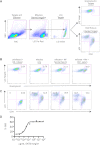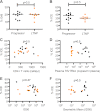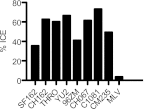Antibody-dependent cellular cytotoxicity against primary HIV-infected CD4+ T cells is directly associated with the magnitude of surface IgG binding
- PMID: 22674985
- PMCID: PMC3421757
- DOI: 10.1128/JVI.00287-12
Antibody-dependent cellular cytotoxicity against primary HIV-infected CD4+ T cells is directly associated with the magnitude of surface IgG binding
Abstract
Antibody (Ab)-dependent cellular cytotoxicity (ADCC) is thought to potentially play a role in vaccine-induced protection from HIV-1. The characteristics of such antibodies remain incompletely understood. Furthermore, correlates between ADCC and HIV-1 immune status are not clearly defined. We screened the sera of 20 HIV-1-positive (HIV-1(+)) patients for ADCC. Normal human peripheral blood mononuclear cells were used to derive HIV-infected CD4(+) T cell targets and autologous, freshly isolated, natural killer (NK) cells in a novel assay that measures granzyme B (GrB) and HIV-1-infected CD4(+) T cell elimination (ICE) by flow cytometry. We observed that complex sera mediated greater levels of ADCC than anti-HIV-1 envelope glycoprotein (Env)-specific monoclonal antibodies and serum-mediated ADCC correlated with the amount of IgG and IgG1 bound to HIV-1-infected CD4(+) T cells. No correlation between ADCC and viral load, CD4(+) T cell count, or neutralization of HIV-1(SF162) or other primary viral isolates was detected. Sera pooled from clade B HIV-1(+) individuals exhibited breadth in killing targets infected with HIV-1 from clades A/E, B, and C. Taken together, these data suggest that the total amount of IgG bound to an HIV-1-infected cell is an important determinant of ADCC and that polyvalent antigen-specific Abs are required for a robust ADCC response. In addition, Abs elicited by a vaccine formulated with immunogens from a single clade may generate a protective ADCC response in vivo against a variety of HIV-1 species. Increased understanding of the parameters that dictate ADCC against HIV-1-infected cells will inform efforts to stimulate ADCC activity and improve its potency in vaccinees.
Figures







Similar articles
-
Beyond Viral Neutralization.AIDS Res Hum Retroviruses. 2017 Aug;33(8):760-764. doi: 10.1089/AID.2016.0299. Epub 2017 Feb 16. AIDS Res Hum Retroviruses. 2017. PMID: 28084796 Free PMC article. Review.
-
HIV-specific CD4-induced Antibodies Mediate Broad and Potent Antibody-dependent Cellular Cytotoxicity Activity and Are Commonly Detected in Plasma From HIV-infected humans.EBioMedicine. 2015 Oct;2(10):1464-77. doi: 10.1016/j.ebiom.2015.09.001. EBioMedicine. 2015. PMID: 26629541 Free PMC article.
-
Antibody-Dependent Cellular Cytotoxicity-Competent Antibodies against HIV-1-Infected Cells in Plasma from HIV-Infected Subjects.mBio. 2019 Dec 17;10(6):e02690-19. doi: 10.1128/mBio.02690-19. mBio. 2019. PMID: 31848282 Free PMC article.
-
Short Communication: Small-Molecule CD4 Mimetics Sensitize HIV-1-Infected Cells to Antibody-Dependent Cellular Cytotoxicity by Antibodies Elicited by Multiple Envelope Glycoprotein Immunogens in Nonhuman Primates.AIDS Res Hum Retroviruses. 2017 May;33(5):428-431. doi: 10.1089/AID.2016.0246. Epub 2016 Dec 19. AIDS Res Hum Retroviruses. 2017. PMID: 27846736 Free PMC article.
-
Impact of HIV-1 Envelope Conformation on ADCC Responses.Trends Microbiol. 2018 Apr;26(4):253-265. doi: 10.1016/j.tim.2017.10.007. Epub 2017 Nov 20. Trends Microbiol. 2018. PMID: 29162391 Review.
Cited by
-
Elimination of SHIV Infected Cells by Combinations of Bispecific HIVxCD3 DART® Molecules.Front Immunol. 2021 Aug 13;12:710273. doi: 10.3389/fimmu.2021.710273. eCollection 2021. Front Immunol. 2021. PMID: 34484212 Free PMC article.
-
Beyond Viral Neutralization.AIDS Res Hum Retroviruses. 2017 Aug;33(8):760-764. doi: 10.1089/AID.2016.0299. Epub 2017 Feb 16. AIDS Res Hum Retroviruses. 2017. PMID: 28084796 Free PMC article. Review.
-
Antibody-dependent cellular cytotoxicity, infected cell binding and neutralization by antibodies to the SIV envelope glycoprotein.PLoS Pathog. 2023 May 30;19(5):e1011407. doi: 10.1371/journal.ppat.1011407. eCollection 2023 May. PLoS Pathog. 2023. PMID: 37253062 Free PMC article.
-
Engineering antibody-based molecules for HIV treatment and cure.Curr Opin HIV AIDS. 2020 Sep;15(5):290-299. doi: 10.1097/COH.0000000000000640. Curr Opin HIV AIDS. 2020. PMID: 32732551 Free PMC article. Review.
-
Antibody responses to envelope glycoproteins in HIV-1 infection.Nat Immunol. 2015 Jun;16(6):571-6. doi: 10.1038/ni.3158. Nat Immunol. 2015. PMID: 25988889 Free PMC article. Review.
References
-
- Ahmad R, et al. 2001. Evidence for a correlation between antibody-dependent cellular cytotoxicity-mediating anti-HIV-1 antibodies and prognostic predictors of HIV infection. J. Clin. Immunol. 21:227–233 - PubMed
-
- Baum LL, et al. 1996. HIV-1 gp120-specific antibody-dependent cell-mediated cytotoxicity correlates with rate of disease progression. J. Immunol. 157:2168–2173 - PubMed
-
- Chung A, Rollman E, Johansson S, Kent SJ, Stratov I. 2008. The utility of ADCC responses in HIV infection. Curr. HIV Res. 6:515–519 - PubMed
Publication types
MeSH terms
Substances
Grants and funding
LinkOut - more resources
Full Text Sources
Other Literature Sources
Research Materials

